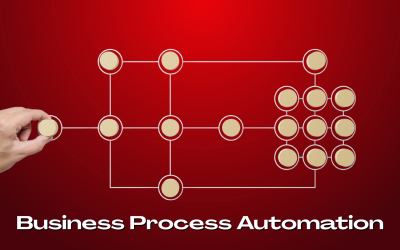RPA Automation
Over the past few years, there has been a major transformation in the business industry. And all because of the tendencies in artificial intelligence. AI has transformed how we do business. We may increase productivity by making rapid, accurate decisions of laborious, time-consuming processes and difficult decisions. One artificial intelligence development that has helped many firms expand is robotic process automation.
Robotic Process Automation (RPA) has fundamentals that can’t be ignored anymore. Like other strategic decisions, RPA’s use in a variety of sectors revolves around the economical use of resources. It has several positive effects on the workplace by freeing human employees of tedious, repetitive labor and enabling them to focus on key business goals.
What is Robotic Process Automation (RPA)?
Software robots that imitate human behavior while interacting with digital systems and software can be created, set up, and managed more easily with the help of robotic process automation (RPA) technology. Similar to humans, software robots can comprehend what’s on a screen, type correctly, navigate systems, recognize and extract data, and carry out a variety of predetermined tasks. But software robots can do it far more quickly and reliably than humans.
Business Benefits of RPA:
Businesses become more adaptable, flexible, and profitable when robotic operations are automated. Furthermore, eliminating tedious chores from the workday raises productivity and enhances employee engagement and happiness. Because RPA is scalable and safe, it speeds up the digital transformation process.
1. Quality and Accuracy:
RPA increases accuracy by providing better services to processes where human error is likely to occur. Robots are reliable, constant, and don’t complain when forced to labor nonstop. They also significantly raise the output quality and decrease the need for reworks. The best part about this is that robots follow all guidelines precisely, which results in 100% accuracy in the process output.
Let’s also not forget about the technology’s quick implementation, which adds even more sweetness to the bargain. RPA maximizes capacities that increase the potential of the organization.
2. Enhanced output:
Not only can automating repetitive processes save time, but it also frees up human workers to focus on their areas of expertise. Employees have less time for innovative ideas because of the time they spend on pointless procedures like copying and pasting data across corporate platforms. Employees cannot do as much work in a day when performing manual jobs since it takes a lot of time and energy.
The RPA modifies this idea. Software robots may improve a team’s productivity by an average of 35% to 50% when they are effectively integrated into operations. In addition, they become more productive as their data processing times decrease. It becomes quite simple to do more in less time.
3. Increased Scalability Opportunities:
Robotic process automation provides the flexibility to change as needed in terms of the nature and quantity of activities required to achieve a certain goal. Businesses can be helped by robotic automation to meet the specific needs of their goals. Even smaller companies can handle the constantly changing needs of the market as the robotic workforce can be changed to meet specific time and task requirements.
4. Boost Your Analytics:
Through the use of RPA technology, businesses can collect information about how tasks are completed that can be used for analysis. Among these are work volume patterns, cycle times, mistakes, and exceptions. Such analysis can yield perceptions that are advantageous in several ways, including boosting efforts toward process improvement. Effective data collection, comparison, and differentiation from data collected in other domains enables improved decision-making at both the micro and macro levels. Furthermore, the organization can identify areas where additional optimization of the business processes could improve efficiency.
5. Easy installation:
RPA implementation is far simpler than you can imagine. To deploy RPA, no technical knowledge and no API setup are needed. As a result, companies save a significant amount of money and time. RPA makes use of unique Graphical User Interface components and sets, in contrast to regular GUI elements. RPA systems are capable of carrying out human tasks like clicking, typing, pressing buttons, and others by using an interface similar to that of humans.
6. Improve business data security:
What worries business executives the most about RPA technologies is how they will affect operational risk. Data leaks and security breaches are already common, and management can be worried about the security of such systems. On the other hand, when RPA parameters are well-specified and properly maintained, platform leaks are often minimal.
RPA has advantageous prospects to minimize the number of human interactions needed for firms processing personal data under stringent laws. Facilitating this retreat and minimizing interaction with sensitive data can help you achieve compliance and make the application of management practices simpler.
7. Boost Customer Support:
Today’s businesses struggle to satisfy the incredibly diverse wants of their client. But in a business that uses RPA, the mundane, repetitive, and routine jobs can be outsourced to robots, freeing up staff members to focus more on providing excellent customer service. Companies can meet the expectations of their customers with the help of skilled and trained professionals. Additionally, they may comprehend the needs of the client by using reports that are automatically created, such as analytics findings.
8. Enhanced Interaction:
RPA triggers and processes can help automate the production and change of documents. Employees won’t have to manually update and monitor minute changes all year long as a consequence. Business procedures can be completed rapidly using robotic process automation, and end users and field personnel can get information.
How can businesses make use of RPA’s potential?
For RPA to benefit your business, it needs a carefully planned design, excellent planning, and strong governance. Modern firms may benefit more from intelligent automation initiatives by integrating RPA with other intelligent technologies like AI, and speech recognition. However, RPA and artificial intelligence (AI) are not the same thing. The primary distinction is that RPA only automates jobs with structured input and requires human interaction. On the other hand, AI advances towards independence by gaining the capacity to reason, comprehend, and analyze unstructured data.
Wrapping It Up:
RPA offers enormous business benefits. It has the power to completely transform our business practices and increase productivity by a factor of ten. RPA implementation in the workplace is more difficult than it first appears. Businesses may find it challenging to get the outcomes they want without careful preparation.
This cutting-edge technology is altering how different firms and business models operate as it revolutionizes process efficiency and boosts productivity across enterprises. RPA enables your company to operate more quickly, intelligently, and effectively. You may start improving everyday results and saving money as soon as you use robotic process automation. Despite the fact that RPA needs some planning, thinking, and consideration of the criteria that will determine its success, it is now easier than ever to take use of its power.






